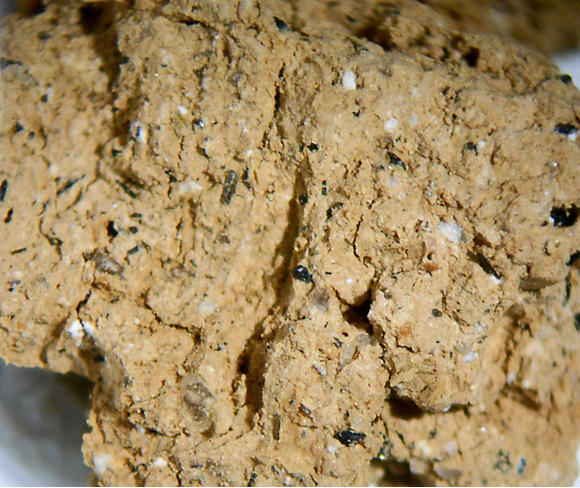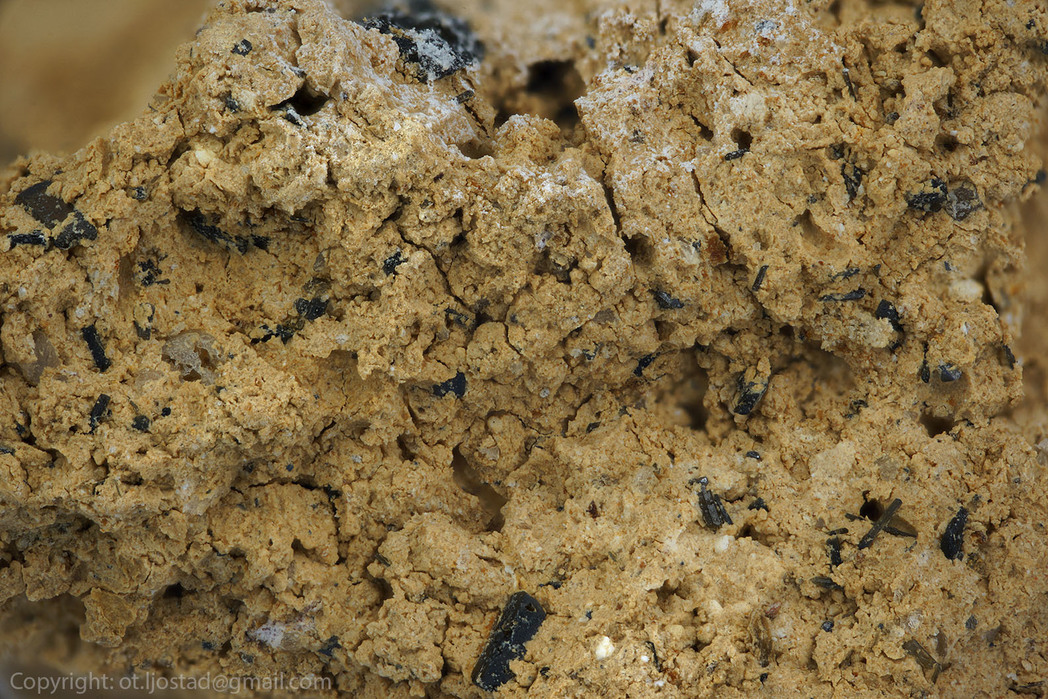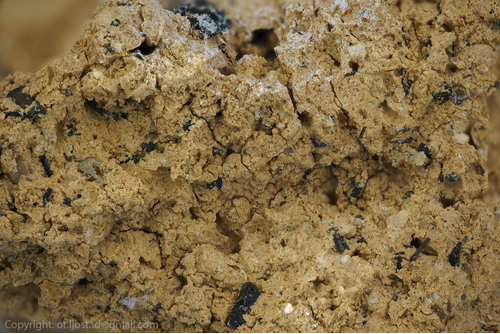Imogolite
A valid IMA mineral species
This page is currently not sponsored. Click here to sponsor this page.
About Imogolite
Formula:
Al2SiO3(OH)4
Colour:
White, blue, green, brown, black
Lustre:
Vitreous, Resinous, Waxy
Hardness:
2 - 3
Specific Gravity:
2.70
Name:
For the Japanese name, Imogo, of the brownish yellow volcanic ash soil of Japan in which it occurs.
Type Locality:
Described in 1962, rejected by the IMA, but the name Imogolite was approved by the AIPEA Nomenclature Committee at its 1970 Tokyo meeting (Clays and Clay Minerals 19, 131 (1971). Reapproved by the CNMMN in 1986.
Widespread component of volcanic-ash-derived soils, but occurs also in other environments. The nano-sized particles have a tube-like morphology. There is longer-range order along the tube but with a cross-section of a few nanometers. The mineral essentially consists of a single modified gibbsite sheet rolled into a tube.
Related to allophane, another nanomineral.
Widespread component of volcanic-ash-derived soils, but occurs also in other environments. The nano-sized particles have a tube-like morphology. There is longer-range order along the tube but with a cross-section of a few nanometers. The mineral essentially consists of a single modified gibbsite sheet rolled into a tube.
Related to allophane, another nanomineral.
Unique Identifiers
Mindat ID:
2021
Long-form identifier:
mindat:1:1:2021:9
GUID
(UUID V4):
(UUID V4):
b0e69d60-253d-4b8b-81a5-5bf034502f1d
IMA Classification of Imogolite
Approved
First published:
1962
Approval history:
Rejected in 1962, approved in 1986.
Type description reference:
Classification of Imogolite
9.ED.20
9 : SILICATES (Germanates)
E : Phyllosilicates
D : Phyllosilicates with kaolinite layers composed of tetrahedral and octahedral nets
9 : SILICATES (Germanates)
E : Phyllosilicates
D : Phyllosilicates with kaolinite layers composed of tetrahedral and octahedral nets
71.1.5.3
71 : PHYLLOSILICATES Sheets of Six-Membered Rings
1 : Sheets of 6-membered rings with 1:1 layers
71 : PHYLLOSILICATES Sheets of Six-Membered Rings
1 : Sheets of 6-membered rings with 1:1 layers
Mineral Symbols
As of 2021 there are now IMA–CNMNC approved mineral symbols (abbreviations) for each mineral species, useful for tables and diagrams.
Please only use the official IMA–CNMNC symbol. Older variants are listed for historical use only.
Please only use the official IMA–CNMNC symbol. Older variants are listed for historical use only.
| Symbol | Source | Reference |
|---|---|---|
| Imo | IMA–CNMNC | Warr, L.N. (2021). IMA–CNMNC approved mineral symbols. Mineralogical Magazine, 85(3), 291-320. doi:10.1180/mgm.2021.43 |
| Imo | Warr (2020) | Warr, L.N. (2020) Recommended abbreviations for the names of clay minerals and associated phases. Clay Minerals, 55, 261–264 doi:10.1180/clm.2020.30 |
Physical Properties of Imogolite
Vitreous, Resinous, Waxy
Transparency:
Transparent, Translucent
Colour:
White, blue, green, brown, black
Hardness:
2 - 3 on Mohs scale
Tenacity:
Brittle
Fracture:
Conchoidal
Density:
2.70 g/cm3 (Measured) 2.70 g/cm3 (Calculated)
Optical Data of Imogolite
Type:
Isotropic
RI values:
n = 1.47 - 1.51
Birefringence:
Isotropic minerals have no birefringence
Surface Relief:
Moderate
Chemistry of Imogolite
Mindat Formula:
Al2SiO3(OH)4
Elements listed:
Crystallography of Imogolite
Cell Parameters:
c = 8.4 Å
Morphology:
Conchoidal to earthy; as microscopic threadlike particles, and bundles of fine tubes, each about 20Å in diameter
Comment:
5.1 perpendicular to c axis
Geological Environment
Paragenetic Mode(s):
| Paragenetic Mode | Earliest Age (Ga) |
|---|---|
| Stage 3a: Earth’s earliest Hadean crust | >4.50 |
| 9 : Lava/xenolith minerals (hornfels, sanidinite facies) | |
| Stage 7: Great Oxidation Event | <2.4 |
| 47a : [Near-surface hydration of prior minerals] | |
| Stage 10a: Neoproterozoic oxygenation/terrestrial biosphere | <0.6 |
| 48 : Soil leaching zone minerals | <0.6 |
Type Occurrence of Imogolite
Geological Setting of Type Material:
Decomposition product of volcanic ash in soils in humid environments.
Reference:
Yoshinaga, N., Aomine, S. (1962) Imogolite in some Ando soils. Soil Science and Plant Nutrition: 8: 114-121.
Other Language Names for Imogolite
Related Minerals - Strunz-mindat Grouping
| 9.ED. | Clinochrysotile | |
| 9.ED.05 | Dickite | Al2(Si2O5)(OH)4 |
| 9.ED.05 | Kaolinite | Al2(Si2O5)(OH)4 |
| 9.ED.05 | Nacrite | Al2(Si2O5)(OH)4 |
| 9.ED.05 | Odinite | (Fe,Mg,Al,Fe,Ti,Mn)2.4((Si,Al)2O5)(OH)4 |
| 9.ED.10 | Halloysite | Al2(Si2O5)(OH)4 |
| 9.ED.10 | Hisingerite | Fe3+2(Si2O5)(OH)4 · 2H2O |
| 9.ED.10 | Hydrohalloysite | Al2Si2O5(OH)4 · 2H2O |
| 9.ED.15 | Amesite | Mg2Al(AlSiO5)(OH)4 |
| 9.ED.15 | Antigorite | Mg3(Si2O5)(OH)4 |
| 9.ED.15 | Berthierine | (Fe2+,Fe3+,Al)3(Si,Al)2O5(OH)4 |
| 9.ED.15 | Brindleyite | (Ni,Al)3(Si,Al)2O5(OH)4 |
| 9.ED.15 | Caryopilite | Mn2+3Si2O5(OH)4 |
| 9.ED.15 | Cronstedtite | Fe2+2Fe3+((Si,Fe3+)2O5)(OH)4 |
| 9.ED.15 | Fraipontite | (Zn,Al)3((Si,Al)2O5)(OH)4 |
| 9.ED.15 | Greenalite | (Fe2+,Fe3+)2-3Si2O5(OH)4 |
| 9.ED.15 | Kellyite | Mn2+2Al(AlSiO5)(OH)4 |
| 9.ED.15 | Lizardite | Mg3(Si2O5)(OH)4 |
| 9.ED.15 | Manandonite | Li2Al4(Si2AlB)O10(OH)8 |
| 9.ED.15 | Népouite | Ni3Si2O5(OH)4 |
| 9.ED.15 | Pecoraite | Ni3(Si2O5)(OH)4 |
| 9.ED.15 | Guidottiite | Mn2Fe3+(Fe3+SiO5)(OH)4 |
| 9.ED.15 va | Chromoamesite | Mg2(Al,Cr)(AlSiO5)(OH)4 |
| 9.ED.20 | Allophane | (Al2O3)(SiO2)1.3-2 · 2.5-3H2O |
| 9.ED.20 | Chrysocolla | Cu2-xAlx(H2-xSi2O5)(OH)4 · nH2O, x < 1 |
| 9.ED.20 | Neotocite | (Mn,Fe,Mg)SiO3 · H2O |
| 9.ED.25 | Bismutoferrite | Fe3+2Bi(SiO4)2(OH) |
| 9.ED.25 | Chapmanite | Fe3+2Sb3+(Si2O5)O3(OH) |
| 9.ED.30 | Pianlinite | Al2Si2O6(OH)2 |
Other Information
Health Risks:
No information on health risks for this material has been entered into the database. You should always treat mineral specimens with care.
Internet Links for Imogolite
mindat.org URL:
https://www.mindat.org/min-2021.html
Please feel free to link to this page.
Please feel free to link to this page.
Search Engines:
External Links:
Mineral Dealers:
References for Imogolite
Reference List:
Bayliss, P. (1987) Mineral nomenclature: imogolite. Mineralogical Magazine, 51 (360) 327 doi:10.1180/minmag.1987.051.360.18 (redefinition)
Localities for Imogolite
Locality List
 - This locality has map coordinates listed.
- This locality has map coordinates listed.
 - This locality has estimated coordinates.
ⓘ - Click for references and further information on this occurrence.
? - Indicates mineral may be doubtful at this locality.
- This locality has estimated coordinates.
ⓘ - Click for references and further information on this occurrence.
? - Indicates mineral may be doubtful at this locality.
 - Good crystals or important locality for species.
- Good crystals or important locality for species.
 - World class for species or very significant.
(TL) - Type Locality for a valid mineral species.
(FRL) - First Recorded Locality for everything else (eg varieties).
- World class for species or very significant.
(TL) - Type Locality for a valid mineral species.
(FRL) - First Recorded Locality for everything else (eg varieties).
All localities listed without proper references should be considered as questionable.
Canada | |
| McKeague et al. (1981) | |
| Wang et al. (1982) | |
| Wang et al. (1986) | |
China | |
| Acta Petrologica et Mineralogica 11 (2) |
Indonesia | |
| Dani Lukman Hakim (2016) |
Japan | |
| Specimens supplied to Iwamoto by Yoshio ... |
| Russell et al. (1969) +1 other reference |
| Alfredo Petrov collection |
New Zealand | |
| Childs et al. (1983) | |
| Childs et al. (1983) |
Tanzania | |
| Schwaighofer et al. (1987) |
UK | |
| Tait et al. (1978) | |
USA | |
| Wada et al. (1972) |
| Bernard et al. (2004) |






 symbol to view information about a locality.
The
symbol to view information about a locality.
The 



Fukaiwa, Kanuma City, Tochigi Prefecture, Japan